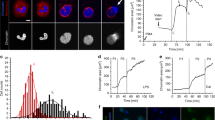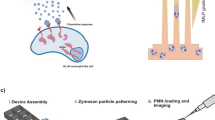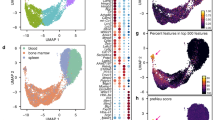Abstract
Neutrophils are essential components of the innate immune system due to their ability to kill and phagocytose invading microbes. They possess a lobulated nucleus and are capable of extensive and complex changes in response to bacterial stimulation. The aim of our study was to investigate whether the 3D nuclear organization of porcine neutrophils was modified upon stimulation. The organization of centromeres, telomeres, and chromosome territories (chromosomes 2, 3, 7, 8, 12, 13, and 17) was studied on structurally preserved nuclei using 3D fluorescence in situ hybridization, confocal microscopy, and image analysis. By differential labeling of centromeres of acrocentric and metacentric/submetacentric chromosomes, we showed that centromeres associated to form chromocenters but did so preferentially between chromosomes with the same morphology. Upon activation, some of these chromocenters dispersed. Telomeres were also found to form clusters, but their number remained unchanged in lipopolysaccharide-stimulated neutrophils. The analysis of the position of chromocenters and telomere clusters showed a more internal location of the latter compared to the former. The analysis of chromosome territories revealed that homologs were distributed randomly among lobes whatever the cell’s status. The volume of these territories was not proportional to chromosome length, and some chromosomes (chr 3, 12, 13, and 17) were more prone to decondensation when neutrophils were stimulated. Thus, our study demonstrated that activation of neutrophils resulted in several modifications of their nuclear architecture: a decrease in the number of non-acrocentric chromocenters and the decondensation of several chromosomes.






Similar content being viewed by others
Abbreviations
- ANOVA:
-
Analysis of variance
- CT:
-
Chromosome territory
- DAPI:
-
4′,6′ Diamidino-2-phenyl indole
- 3D FISH:
-
Three-dimensional fluorescence in situ hybridization
- DOP-PCR:
-
Degenerate oligonucleotide primed polymerase chain reaction
- FITC:
-
Fluorescein isothiocyanate
- LPS:
-
Lipopolysaccharide
- PNA:
-
Peptide nucleic acid
- SNR:
-
Signal-to-noise ratio
- SSC:
-
Sus scrofa domestica
References
Adega F, Chaves R, Guedes-Pinto H (2005) Chromosome restriction enzyme digestion in domestic pig (Sus scrofa) constitutive heterochromatin arrangement. Genes Genet Syst 80:49–56
Alcobia I, Dilão R, Parreira L (2000) Spatial associations of centromeres in the nuclei of hematopoietic cells: evidence for cell-type-specific organizational patterns. Blood 95:1608–1615
Amrichová J, Lukásová E, Kozubek S, Kozubek M (2003) Nuclear and territorial topography of chromosome telomeres in human lymphocytes. Exp Cell Res 289:11–26
Aquiles Sanchez J, Karni RJ, Wangh LJ (1997) Fluorescent in situ hybridization (FISH) analysis of the relationship between chromosome location and nuclear morphology in human neutrophils. Chromosoma 106:168–177
Bártová E, Kozubek S, Jirsová P, Kozubek M, Lukásová E, Skalníková M, Cafourková A, Koutná I, Paseková R (2001) Higher-order chromatin structure of human granulocytes. Chromosoma 110:360–370
Bridger JM, Boyle S, Kill IR, Bickmore WA (2000) Re-modelling of nuclear architecture in quiescent and senescent human fibroblasts. Curr Biol 10:149–152
Brown KE, Amoils S, Horn JM, Buckle VJ, Higgs DR, Merkenschlager M, Fisher AG (2001) Expression of alpha- and beta-globin genes occurs within different nuclear domains in haemopoietic cells. Nat Cell Biol 3:602–306
Cremer T, Cremer C (2001) Chromosome territories, nuclear architecture and gene regulation in mammalian cells. Nat Rev Genet 2:292–301
Cremer M, Küpper K, Wagler B, Wizelman L, von Hase J, Weiland Y, Kreja L, Diebold J, Speicher MR, Cremer T (2003) Inheritance of gene density-related higher order chromatin arrangements in normal and tumor cell nuclei. J Cell Biol 162:809–820
Cremer T, Cremer M, Dietzel S, Müller S, Solovei I, Fakan S (2006) Chromosome territories—a functional nuclear landscape. Curr Opin Cell Biol 18:307–316
Daniel A, St Heaps L (2004) Chromosome loops arising from intrachromosomal tethering of telomeres occur at high frequency in G1 (non-cycling) mitotic cells: implications for telomere capture. Cell Chromosome 3:3
Foster HA, Bridger JM (2005) The genome and the nucleus: a marriage made by evolution. Genome organisation and nuclear architecture. Chromosoma 114:212–229
Gué M, Messaoudi C, Sun JS, Boudier T (2005) Smart 3D-FISH: Automation of distance analysis in nuclei of interphase cells by image processing. Cytometry A 67:18–26
Haaf T, Schmid M (1991) Chromosome topology in mammalian interphase nuclei. Exp Cell Res 192:325–332
Hepperger C, Mayer A, Merz J, Vanderwall DK, Dietzel S (2009) Parental genomes mix in mule and human cell nuclei. Chromosoma 118:335–347
Karni RJ, Wangh LJ, Sanchez JA (2001) Nonrandom location and orientation of the inactive X chromosome in human neutrophil nuclei. Chromosoma 110:267–274
Kim SH, McQueen PG, Lichtman MK, Shevach EM, Parada LA, Misteli T (2004) Spatial genome organization during T-cell differentiation. Cytogenet Genome Res 105:292–301
Kobayashi SD, Braughton KR, Whitney AR, Voyich JM, Schwan TG, Musser JM, DeLeo FR (2003) Bacterial pathogens modulate an apoptosis differentiation program in human neutrophils. Proc Natl Acad Sci USA 100:10948–10953
Kuroda M, Tanabe H, Yoshida K, Oikawa K, Saito A, Kiyuna T, Mizusawa H, Mukai K (2004) Alteration of chromosome positioning during adipocyte differentiation. J Cell Sci 117:5897–5903
Lanctôt C, Cheutin T, Cremer M, Cavalli G, Cremer T (2007) Dynamic genome architecture in the nuclear space: regulation of gene expression in three dimensions. Nat Rev Genet 8:104–115
Lloyd AR, Oppenheim JJ (1992) Poly’s lament: the neglected role of the polymorphonuclear neutrophil in the afferent limb of the immune response. Immunol Today 13:169
Lunney JK (2007) Advances in swine biomedical model genomics. Int J Biol Sci 3:179–184
Manuelidis L (1990) A view of interphase chromosomes. Science 250:1533–1540
Mayer R, Brero A, von Hase J, Schroeder T, Cremer T, Dietzel S (2005) Common themes and cell type specific variations of higher order chromatin arrangements in the mouse. BMC Cell Biol 6:44
Meyer-Ficca M, Müller-Navia J, Scherthan H (1998) Clustering of pericentromeres initiates in step 9 of spermiogenesis of the rat (Rattus norvegicus) and contributes to a well defined genome architecture in the sperm nucleus. J Cell Sci 111:1363–1370
Misteli T (2007) Beyond the sequence: cellular organization of genome function. Cell 128:787–800
Murphy WJ, Larkin DM, Everts-van der Wind A, Bourque G, Tesler G, Auvil L, Beever JE, Chowdhary BP, Galibert F, Gatzke L, Hitte C, Meyers SN, Milan D, Ostrander EA, Pape G, Parker HG, Raudsepp T, Rogatcheva MB, Schook LB, Skow LC, Welge M, Womack JE, O'brien SJ, Pevzner PA, Lewin HA (2005) Dynamics of mammalian chromosome evolution inferred from multispecies comparative maps. Science 309:613–617
Nagele RG, Velasco AQ, Anderson WJ, McMahon DJ, Thomson Z, Fazekas J, Wind K, Lee H (2001) Telomere associations in interphase nuclei: possible role in maintenance of interphase chromosome topology. J Cell Sci 114:377–388
Newburger PE, Subrahmanyam YV, Weissman SM (2000) Global analysis of neutrophil gene expression. Curr Opin Hematol 7:16–20
Pinheiro J, Bates D, DebRoy S, Sarkar D and the R Core team (2008) nlme: linear and nonlinear mixed effects models. R package version 3.1-89
Pita M, Garcia-Casado P, Toro MA, Gosálvez J (2008) Differential expansion of highly repeated DNA sequences in the swine subgenomes. J Zool Syst Evol Res 46:186–189
R Development Core Team (2005) R: a language and environment for statistical computing. R Foundation for Statistical Computing, Vienna http://www.R-project.org. ISBN 3-900051-07-0
Rogel-Gaillard C, Bourgeaux N, Save JC, Renard C, Coullin P, Pinton P, Yerle M, Vaiman M, Chardon P (1997a) Construction of a swine YAC library allowing an efficient recovery of unique and centromeric repeated sequences. Mamm Genome 8:186–192
Rogel-Gaillard C, Hayes H, Coullin P, Chardon P, Vaiman M (1997b) Swine centromeric DNA repeats revealed by primed in situ (PRINS) labeling. Cytogenet Cell Genet 79:79–84
Sanchez JA, Wangh LJ (1999) New insights into the mechanisms of nuclear segmentation in human neutrophils. J Cell Biochem 73:1–10
Solovei I, Schermelleh L, Düring K, Engelhardt A, Stein S, Cremer C, Cremer T (2004) Differences in centromere positioning of cycling and postmitotic human cell types. Chromosoma 112:410–423
Solov'eva L, Svetlova M, Bodinski D, Zalensky AO (2004) Nature of telomere dimers and chromosome looping in human spermatozoa. Chromosome Res 12:817–823
Soutoglou E, Misteli T (2008) On the contribution of spatial genome organization to cancerous chromosome translocations. J Natl Cancer Inst Monogr 39:16–19
Stadler S, Schnapp V, Mayer R, Stein S, Cremer C, Bonifer C, Cremer T, Dietzel S (2004) The architecture of chicken chromosome territories changes during differentiation. BMC Cell Biol 5:44
Telenius H, Carter NP, Bebb CE, Nordenskjöld M, Ponder BA, Tunnacliffe A (1992) Degenerate oligonucleotide-primed PCR: general amplification of target DNA by a single degenerate primer. Genomics 13(3):718–725
Tsukahara Y, Lian Z, Zhang X, Whitney C, Kluger Y, Tuck D, Yamaga S, Nakayama Y, Weissman SM, Newburger PE (2003) Gene expression in human neutrophils during activation and priming by bacterial lipopolysaccharide. J Cell Biochem 89:848–861
Weierich C, Brero A, Stein S, von Hase J, Cremer C, Cremer T, Solovei I (2003) Three-dimensional arrangements of centromeres and telomeres in nuclei of human and murine lymphocytes. Chromosome Res 11:485–502
Yerle M, Schmitz A, Milan D, Chaput B, Monteagudo L, Vaiman M, Frelat G, Gellin J (1993) Accurate characterization of porcine bivariate flow karyotype by PCR and fluorescence in situ hybridization. Genomics 16:97–103
Yerle M, Goureau A, Gellin J, Le Tissier P, Moran C (1994) Rapid mapping of cosmid clones on pig chromosomes by fluorescence in situ hybridization. Mamm Genome 5:34–37
Zalenskaya IA, Zalensky AO (2004) Non-random positioning of chromosomes in human sperm nuclei. Chromosome Res 12:163–173
Zalensky AO, Tomilin NV, Zalenskaya IA, Teplitz RL, Bradbury EM (1997) Telomere–telomere interactions and candidate telomere binding protein(s) in mammalian sperm cells. Exp Cell Res 232:29–41
Acknowledgments
We thank Dr. Thomas Boudier for his advice and help in the implementation of Smart 3D-FISH software. We are grateful to Drs. Janice Britton-Davidian, Eve Devinoy, and Gauthier Dobigny for very helpful and stimulating discussions on the manuscript. This research was supported in part by the GENANIMAL program.
Author information
Authors and Affiliations
Corresponding author
Additional information
Responsible Editor: Fengtang Yang.
Appendix. Supplementary data
Appendix. Supplementary data
Supplementary data (figures) associated with this article can be found at https://www-lgc.toulouse.inra.fr/internet/index.php/Supplemental-data/View-category.html.
Rights and permissions
About this article
Cite this article
Yerle-Bouissou, M., Mompart, F., Iannuccelli, E. et al. Nuclear architecture of resting and LPS-stimulated porcine neutrophils by 3D FISH. Chromosome Res 17, 847–862 (2009). https://doi.org/10.1007/s10577-009-9074-6
Received:
Revised:
Accepted:
Published:
Issue Date:
DOI: https://doi.org/10.1007/s10577-009-9074-6




